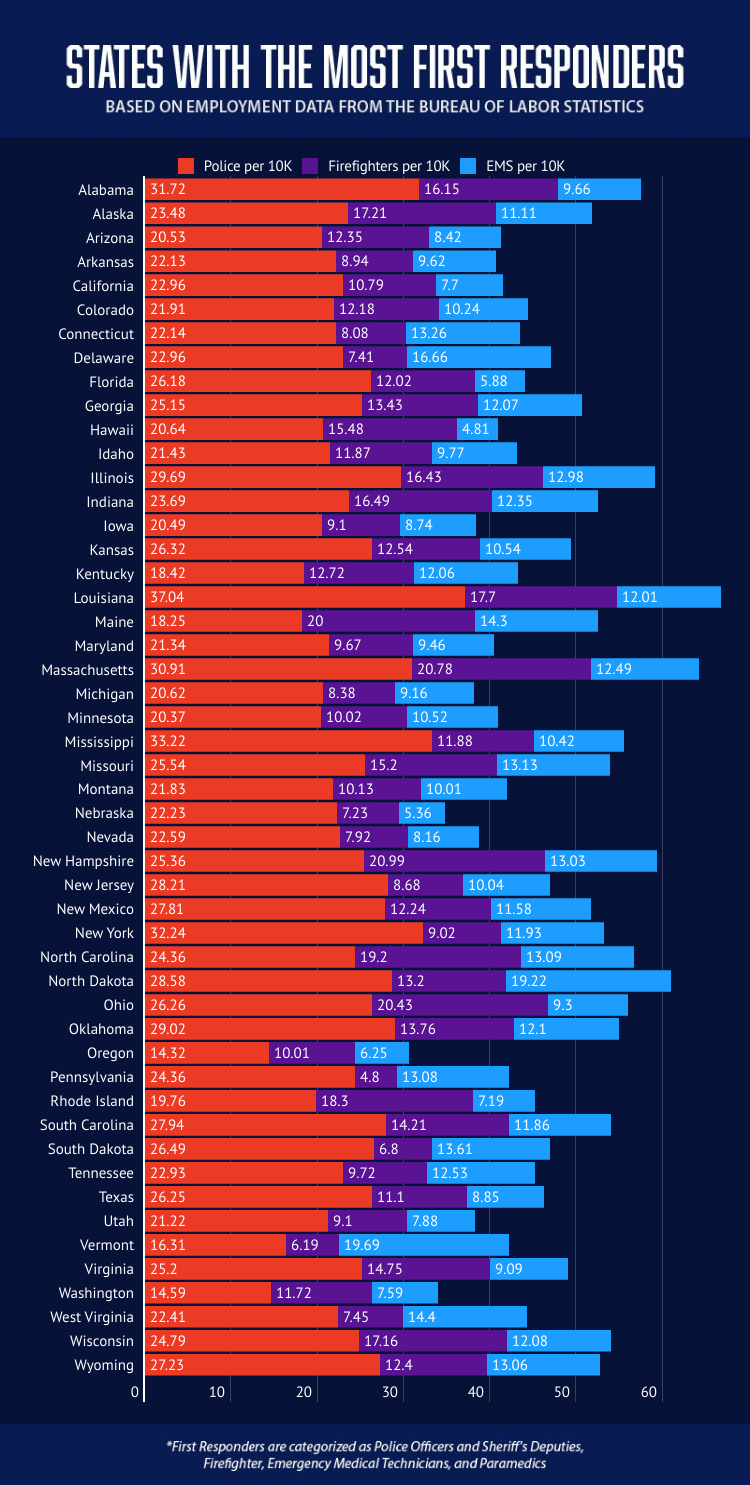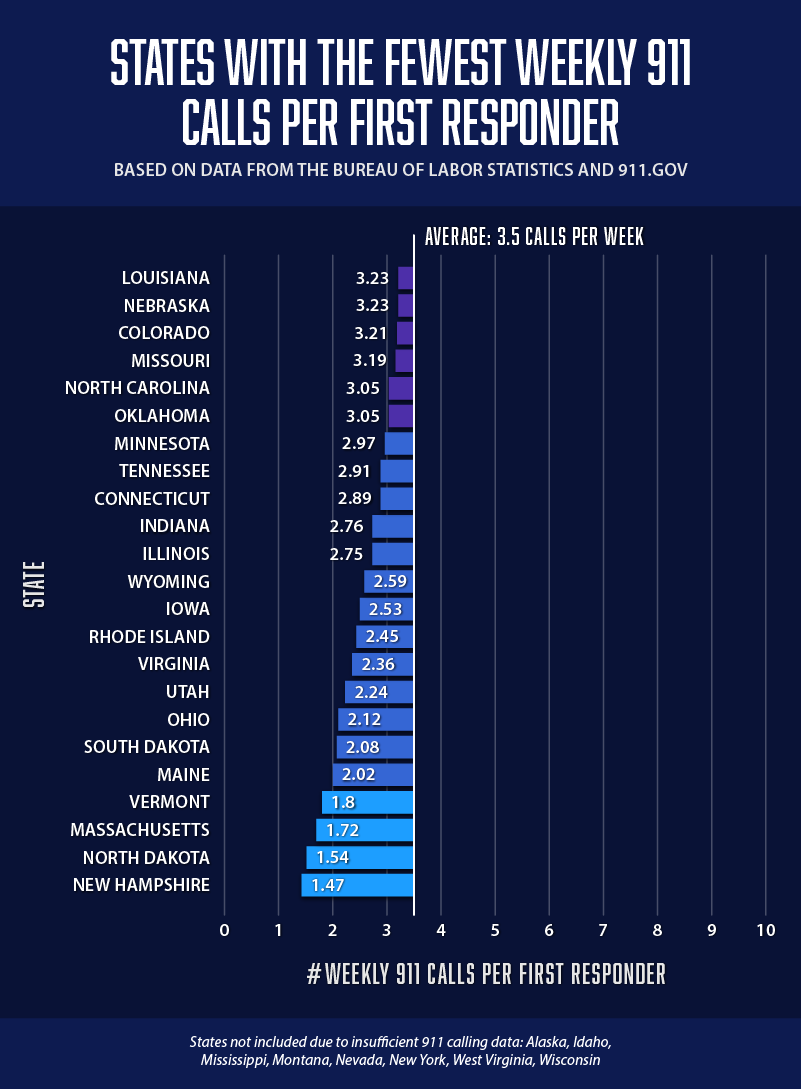.webp)
First responders, whether police officers, firefighters, or EMS workers, are the backbone of our nation's emergency response system, ensuring prompt and effective assistance during times of crisis.
This prompted the Rainbow Restoration® team to delve into the prevalence of first responders across the U.S. The number of first responders per capita and the distribution of different types of first responders across every state were examined. To add a layer of analysis, the ratio of emergency calls to first responders in each state were analyzed to identify regions where emergency situations may exceed the availability of responders.
Explore how the number of first responders correlates with the frequency of 911 calls, shedding light on the critical role these individuals play in ensuring public safety during emergencies.
U.S. States With the Most First Responders
.webp)
When it comes to emergency preparedness and response, the density of first responders plays a role in ensuring swift assistance during times of crisis. Our analysis reveals some significant regional variations in first responder density across the United States. Some states have a higher concentration of these vital personnel per capita compared to others and much more than the national average of 48 first responders per 10,000 people.
Louisiana stands out as the state where the ratio is an impressive 67 first responders per 10,000 people. Considering that Louisianans have experienced the second-most property damage from severe weather events since 2000, this elevated density demonstrates the state’s ample supply of emergency services.
Following closely behind is Massachusetts, with 64 first responders per 10,000 people. This statistic reflects the state's approach to emergency management and highlights its emphasis on ensuring the safety of its residents. North Dakota also has a standout ratio with a density of 61 first responders per 10,000 people.
Two more states come in with just under the 60 first responders per capita mark. New Hampshire and Illinois both have 59 per 10,000 people. These figures show that the cache of effective emergency assistance stretches across the U.S.
Where Are First Responders Located in the U.S.?

Diving deeper into the analysis, a closer examination was made of the distribution of different types of first responders around the country. The data provides insights into the states with the highest concentration of police officers, firefighters, and emergency medical service (EMS) workers per capita, demonstrating emergency response infrastructure nationwide.
Police Officers:
Louisiana also emerges as a frontrunner in police officer density, with 37 officers per 10,000 people. This figure well surpasses the national average of 24, highlighting the state's supply of law enforcement, attempting to ensure public safety.
The state with the second-most is Mississippi, with 33 police officers per 10,000 people. New York follows closely with 32. The density of police officers in each state underscores their availability of law enforcement for emergency situations.
Firefighters:
Turning our attention to firefighters, New Hampshire and Massachusetts lead the pack with 21 firefighters per 10,000 people, about 60% more than the national average of 13. This substantial density highlights an increased reserve of firefighters and emergency response, which can contribute to an enhanced feeling of public safety.
Ohio also has plenty of firefighters with 20 per 10,000 people, reflecting its stock of prepared first responders to address fire-related emergencies effectively.
EMS Workers:
In terms of EMS workers, Vermont emerges as a standout with 20 workers per 10,000 people, outpacing the national average of 11. This emphasis on emergency medical services highlights its desire to provide prompt and efficient medical assistance to those in need.
North Dakota follows closely behind with 19 EMS workers per 10,000 people, reflecting an ample supply of emergency medical responders to safeguard the health of its residents. Delaware has the third most EMS workers with 17 per 10,000 people.
These statistics provide some insights into the allocation of emergency response resources and highlight the importance of a well-equipped and adequately staffed first responder network in safeguarding communities nationwide.
911 Call Frequency per First Responder
.webp)
Understanding the relationship between 911 call frequency and the availability of first responders can paint a picture of the emergency response capabilities across different states. To explore this relationship, we examined the weekly 911 calls per first responder in every state, which offers some insight into the workload and demand for emergency services across the U.S.
Michigan emerges as the state with the highest ratio of emergencies to responders. It has 9.3 weekly 911 calls per first responder, significantly higher than the national average of 3.5. The Great Lake State made 147 emergency calls per 100 residents in 2021, about 84% more than the national average.
New Mexico follows closely behind with 6 weekly 911 calls per first responder, reflecting a notable demand for emergency services in the state while Hawaii (the state with the third most) registers slightly less at 5.8.

On the other end of the spectrum, states like New Hampshire and North Dakota stand out with just 1.5 weekly calls per first responder, significantly less than the nationwide average.
This statistic suggests a relatively lower demand for emergency services in these states compared to others, reflecting variations in emergency call volume across different regions. It’s also worth noting that both New Hampshire and North Dakota have relatively large populations of first responders per capita.
Massachusetts has the third-lowest rate of weekly 911 calls per first responder at 1.7.
Closing Thoughts
The analysis has provided insight into the distribution of first responders and their crucial role in emergency response. Examining the states with the highest concentration of first responders and exploring the correlation between 911 call frequency and the availability of emergency personnel offers perspective on regional variations in emergency response capabilities.
Emergencies happen, and when they do, first responders are often there to help with the immediate impact but the aftermath can leave property and business owners feeling lost as they try to pick up the pieces. If an unexpected flood, fire, or traumatic event causes substantial property damage, Rainbow Restoration offers both residential and commercial restoration services to help restore lives and communities.
Methodology
To conduct our study on first responders, we found the number of police officers and sheriff’s deputies, firefighters, emergency medical technicians, and paramedics employed in every state from the Bureau of Labor Statistics. We positioned the total number against the working-age population in every state to allow for more accurate comparisons.
We also wanted to learn more about the relationship between potential emergency situations and first responder density. To do this, we found the total number of 911 calls from every state where the data was available using 911.gov and positioned that against the number of first responders in each state. This data shows the areas of the country where emergency calls outpace first responder availability.
